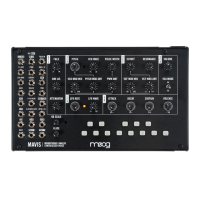12 | About Mavis
About Mavis
Mavis is a complete, compact, and powerfully equipped analog synthesizer. The built-in
keyboard, select hardwired connections, and remarkable sound engine provide Mavis
with plenty of musical dexterity to stand all on its own. On-board utilities and an array of
inclusive patch points transform Mavis into the archetype of a modular synthesizer, able
to work in concert with other modular, semi-modular, or Eurorack instruments and other
electronic music equipment. Once assembled, you will have the satisfaction of owning a
100% analog Moog synthesizer that you’ve built yourself. A lifetime of rewarding
synthesizer experiences await.
ANALOG SYNTHESIZER BASICS
Analog synthesis relies on two types of signals: audio signals and control signals. Audio signals are the
sounds you hear emanating from the sound creation circuits of an instrument. Control signals, on the
other hand, are used to change and/or modify the settings of these circuits. In an analog instrument,
these control signals carry a continuously variable voltage level. These signals are referred to as Control
Voltages, and many parameters of an analog synthesizer’s modules are “Voltage Controlled.” An
additional type of control signal is known as a Gate, or Trigger, which is simply used to initiate an event.
Pressing a key on a keyboard is an example of generating a Gate signal.
In an analog synthesizer, each set of circuits performs a particular job—the oscillators, filters, envelopes,
etc.—are each self-contained modules. By design, these modules are wired together using both audio
signals and control signals. However, patch points and patch cables can allow these modules to be
reconnected in new ways. This is the basis for the term Modular Synthesizer. The first Moog synthesizers
were modular synthesizers.
In this diagram of Mavis modules, the solid lines represent audio signals, and the dotted lines represent
control signals. The definitions and functions of each module are described later in the "Panel Controls &
Functions" section (page 20).

